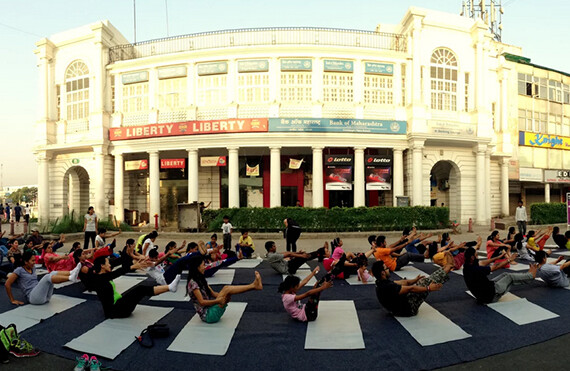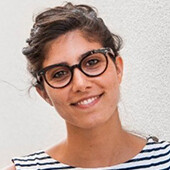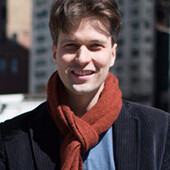This interview has been edited for brevity and clarity.
There is a lack of consideration for "place" in American urban planning that Ethan Kent finds concerning. It offends him the way ugly typography offends graphic designers. He works as senior vice president of Project for Public Spaces (PPS) in New York, where they are trying to turn the way we shape cities upside down. Over its 40-year history PPS has focused on turning public spaces into great places. How? Just visit their offices in Manhattan. The entrance is like the jungle.
IRENE PEDRUELO: Forty years ago "success" for a city was a synonym for growth, cars, and tall buildings. At the time, PPS was almost alone in battling this idea of success. But it seems that policymakers and thinkers are changing their minds and entering a new philosophical cycle that reassesses the old idea of city success.
ETHAN KENT: Our work started in the 1970s, looking at how you make public places work for people. It was a time when people were running from cities to the suburbs. We were living in this anti-urban era, when people really were designing cities and public spaces out of fear. Cities have been shaped by the buildings, the block, top-down architecture, often to the detriment of places and communities.
IRENE PEDRUELO: How was PPS born?
ETHAN KENT: The organization was founded by my father. We were set up to apply the work of William Whyte who had been doing research with my father on the social life of public spaces. [Whyte] was a writer and theorist, and was the editor for Jane Jacobs, both for the article in Fortune magazine and the book The Death and Life of Great American Cities. We call the approach PPS has developed over the last four decades “placemaking,” and it revolves around the idea of how we can make public spaces attractive and better serve communities.
IRENE PEDRUELO: You have been critical of the approach to urban planning taken by many policymakers over the decades. Why?
ETHAN KENT: Citizenship has been whittled down to just voting and engaging passively. I think the biggest crisis in the world is that we are at a low point in how we all participate in shaping our communities. We see placemaking as a means to challenge and empower everyone to take responsibility for the world beyond their home. We found the focus on place to be an essential strategy for turning upside down the way we shape cities and the culture of governance. People have receded inside their homes and we try to help them see that the public realm is one that generates shared wealth for them if they contribute to it. It's about getting them to be parts of their communities again.
 Ethan Kent, senior vice-president at Project For Public Spaces, in New York.
Ethan Kent, senior vice-president at Project For Public Spaces, in New York.
IRENE PEDRUELO: What is "place" for you?
ETHAN KENT: A place is how we are attached to our community, how we experience our world and our community. It's really the patterns of social activity, the cultural openness, commercial and cultural relationships that make a place. There is no formal discipline that is really delivering "place." Just having a space be public space alone isn't often giving value to places, and design is only a small part of what makes a place work.
IRENE PEDRUELO: This idea of putting citizens at the center of the decision-making process is a very nice one, but, many would argue, an unrealistic one. The reality is that citizens are rarely the main drivers. In the end, wealthy families like the Rockefellers and the Vanderbilts, politicians, developers, etc. end up having such a huge impact! And they all pursue different goals: some are looking for profit; others want a more efficient transportation system to get to their house, etc.
ETHAN KENT: The story of New York is one of community-based change, although it is not the story that is told, necessarily. What makes New York great are public spaces like the High Line or Bryant Park that have really been defined by their communities. Businesses, groups of friends, neighborhood alliances, etc., self-governed themselves, and transformed and preserved New York at the human scale.
IRENE PEDRUELO: So you think that we have power as citizens?
ETHAN KENT: I think the story of New York and the places that are most loved in New York have been created by citizens. The city wants to take credit and formalize a lot of these changes, but really, to replicate and preserve great spaces, we need to support these place-led community-based processes, or at least, allow for them to happen. At PPS we are involved in shifting governance around the world. In Australia, for example, where there is very little community-based process, they've realized that a lot of the innovation can't come from government, and they are starting to see the role of government as building the capacity for communities to change. What we are talking about is devolving government to the community.
IRENE PEDRUELO: Are there any remarkable examples?
ETHAN KENT: The city of Adelaide is the one that has taken us the furthest. We've developed with them a "place capital metric" so they can measure their success based on the shared value of the public realm.
IRENE PEDRUELO: How do you measure something as intangible and unquantifiable as "shared value"?
ETHAN KENT: The place capital metric is a quantitative and qualitative measurement system. We measure how businesses are doing, how many people are using the spaces, stationary activity, whether people are gathering in groups, whether there are enough women, children, and elderly in the public space, etc. And then there are qualitative assessments to evaluate the feeling of safety and comfort. We ask: Are there reasons to be in the space, and how does the space serve the community?
IRENE PEDRUELO: Can we judge American cities and this idea of “place” you were talking about with European standards? Is that fair?
ETHAN KENT: Many urbanists feel that European landscape-use patterns are as good as they can get in some ways. In the United States, we used to write off the suburbs saying that that is not the future, but there is more demand for public spaces there than anywhere else. The suburbs are becoming the new inner cities.You have "place deserts" throughout the American landscape, and there is a great need for creating good public spaces there. There is a great demand for places that people want to be in. Authentic and unique places will succeed in the future.
IRENE PEDRUELO: It seems we have gone through this era where every city was trying to do the same thing. Do you think this is really changing?
ETHAN KENT: We've been immersed in a sort of monoculture regarding urbanism, and we have exported that. The rest of the world has been copying the worst mistakes of America, and it is still copying. A big part of our role is basically telling people not to make the same mistakes that we made.
IRENE PEDRUELO: This is one of the main criticisms also in the international development world: outsiders or master planners parachuting in and out to teach locals how to do things “their way.”
ETHAN KENT: We are going through an era of Ted Talks and solutionism; the era of foundations looking for the idea that is going to go viral, the small investment that will have huge impact and change the world. It's a narrow idea of innovation. We think that what really is changing the world is more collective innovation, culture change, community creativity, and . . . it's out there in the world.
IRENE PEDRUELO: Are we too focused on Silicon Valley-driven innovation?
ETHAN KENT: There is this myth that discoveries revolve around us, the United States or the Global North. But that is quickly changing. I think we live in a more networked world of change, and it is very clear that a lot of the best thinking and innovation is coming from South-South cooperation.
IRENE PEDRUELO: How do we change the conversation?
ETHAN KENT: There is a global elite that is causing cities to look the same, and pushing the same idea of what modern is and what development means. Culture is the most powerful force that people don't talk about. It's this global elite's culture that is in the airline magazines. At the same time I think that people, even this global elite, are just going after what they are told is cool. We found it is pretty easy to convince them that, for example, great public markets can be cool.
IRENE PEDRUELO: There are many myths around city-planning. Let's take Indian cities as an example. In many cases Westerners consider them chaotic or disordered, but they rarely consider that it may be a different kind of order.
ETHAN KENT: I have walked around with leaders in Indian cities, where they were very embarrassed by this "chaos" and "messy" streets. In the meantime, in the United States we are working so hard to give some informality and life back to our public spaces and infrastructure! In some places informal governance of informal settlements is closer to getting it right. People are increasingly understanding that informal settlements and slums are doing more right than wrong on many levels. They are more efficiently providing housing than a lot of the new public housing and such. There is a lot to learn.
IRENE PEDRUELO: Then why are many trying to suppress this kind of urban planning?
ETHAN KENT: The culture of global development is very much trying to order and organize chaotic streets and communities, often undermining the emergent creativity of these places. It is not to glorify the problems but it's to say that in some ways they are creating better public spaces, better community outcomes, than the more top-down solutions that are being introduced to solve their problems.
IRENE PEDRUELO: Why then the obsession for replicating Western monuments and projects all over the world?
ETHAN KENT: The construction of the Guggenheim Museum created attention for a city, Bilbao, and got empirical results. [It was coined] the "Bilbao effect." But then every city tried to copy the idea of just creating fancy architecture alone. Unfortunately the story of the High Line that is being replicated around the world is just that of a very expensive piece of infrastructure and design object that will attract tourism. And that to us is a zero-sum game. We can have great buildings if that is what people are willing to pay for, but why not also have great public spaces.
IRENE PEDRUELO: Who are public spaces for?
ETHAN KENT:In the best public spaces everyone contributes to everyone else's experience. You want people competing for public space; this is what will make it dynamic. If any group of people—criminals, homeless people, etc.—is culturally or physically dominating a public space that is privatization. They are preventing it from being publicly beneficial to others. It's always about trying to attract different user groups to a space, because that is what is creating its public benefit.
IRENE PEDRUELO: Cities are a hot topic now and happiness seems to be too. It may have to do with the success of the book The Happy City by Charles Montgomery. Should happiness be the goal that we pursue when designing a city?
ETHAN KENT: The livability or quality of life lists [that are published every year] look at cities that best balance economic competitiveness and leisure activity, which are the most expensive cities in the world. This is perpetuating one very linear approach to development. The interest of people to live in those cities is being perpetuated by getting people to invest further in that vision and values. I think is more about loveabilty, attachment and comfort; and those qualities can occur in some of the poorest parts of the world too. Many of those places are doing it better than in places that are more liveable.
IRENE PEDRUELO: So loveable, huh?
ETHAN KENT: People with most attachment to a place are the ones that love the place the most. Where there is no community-based governance, there is no attachment. We need to pay attention to place and community, and the social networks around it. Placemaking has fallen between the cracks of all the other causes and challenges, but we see it as a center to address.
IRENE PEDRUELO: How do you see the idea of placemaking playing in massive cities like Tokyo, Jakarta, and Seoul?
ETHAN KENT: These megacities need to work at the small community level. There is a big emphasis on big infrastructure. We talk about building infrastructure but we don't talk about how that infrastructure supports community outcomes and leverages those investments for place as well. It's about creating great places in both rural and urban areas.
IRENE PEDRUELO: If you had to choose an example of public space that works, what would that be?
ETHAN KENT: Some of the places that I most love are markets. It's not about the size of the open space or the amount of money that is spent on it. It is the purpose and life that they continually create; as well as the culture and economic outcomes that they generate and sustain as well.
IRENE PEDRUELO: PPS came up with 10 things that make a public space great. What is the magic formula?
ETHAN KENT: A good place has at least 10 reasons to be in it, and what gets people to come back to a place or to have a memorable experience is the layering of things in it. We are often told that the aesthetics and the infrastructure, the form of the space is the most important factor. Those play a role, but it is really about how those support uses and purpose to the space. A great destination, whether is a street or a square, has at least ten places on it with at least ten things to do in each. A great city has at least ten great destinations or districts. New York is really defined by its public destinations. If it didn't have communities creating them, it would not have any level of attachment or the investment that it has. It is not just about liveability or quality of life, it's this loveability and emergent creativity of a city that allows for success.
Policy Innovations' Six Quick Questions
What are the three main attributes of an innovator? We have been taught that innovation is about individual creativity and the ability to sell and push solutions. But I think it's about how we facilitate informed networks of people and inspire them to lead change themselves.
What does social innovation mean to you? Social innovation is really changing our relationships, our networks, our governance. Social innovation is changing our capacity to create change.
What other obsessions do you have in addition to cities? I do work and I take care of kids. My wife and I are both energized by travel. I love to travel with a purpose, and to feel connected to all these places.
Where do you see yourself in 20 years?Getting to be an integral part of these networks of people changing their communities.
Life is about . . . emergent relationships to people and places.
What would you tell your younger self if you had to start over? Every experience you have and everything you learn you will get to use and apply in future situations coming.





